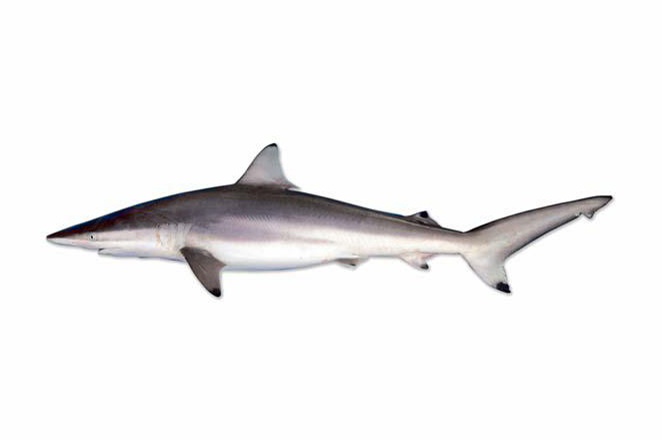Spinner Shark, Carcharhinus brevipinna (Valenciennes 1839)
Other Names: Eastern Sand Shark, Inkytail Shark, Inky-tail Shark, Longnose Grey Shark, Long-nose Grey Shark, Long-nosed Grey Shark, Smoothfang Shark, Smooth-fanged Shark

Spinner Shark, Carcharhinus brevipinna. Source: NOAA/NMFS, E. Hoffmayer, S. Iglésias and R. McAuley. License: Public Domain
Summary:
A grey shark with a white underside, a conspicuous white band along sides, and subadults and adults with black or dark grey tips to all fins except the pelvic fins, and noticeably small teeth in the upper jaw.
A grey shark with a white underside, a conspicuous white band along sides, and subadults and adults with black or dark grey tips to all fins except the pelvic fins, and noticeably small teeth in the upper jaw.
Cite this page as:
Reardon, M.B. & Bray, D.J. 2023, Carcharhinus brevipinna in Fishes of Australia, accessed 17 Apr 2024, https://fishesofaustralia.net.au/Home/species/2884
Spinner Shark, Carcharhinus brevipinna (Valenciennes 1839)
More Info
|
Distribution |
South of Geographe Bay, south Western Australia, around the tropical north to off Tathra, southern New South Wales. Elsewhere the species is found worldwide in warm temperate, subtropical and tropical continental and insular shelf waters. Mostly inhabits inshore waters in bays, off beaches and river mouths. The species is also pelagic in offshore waters. |
|
Features |
Body slender, snout long, narrow, pointed, gill slits long. Upper jaw teeth small, very slender, with erect cusps. First dorsal fin small; interdorsal ridge absent; labial furrows conspicuous. |
|
Feeding |
Feeds mostly on bony fishes; also consumes small rays and cephalopods. |
|
Biology |
Males mature at 170–220 cm TL and females at 160–222 cm TL. Reproduction is viviparous with a yolk-sac placenta and litter sizes of 3–15, a biennial reproductive cycle, and size-at-birth of 48–80 cm TL. Nursery grounds occur in shallow, near-shore waters. |
|
Fisheries |
In Australia, the species is caught as bycatch in Western Australian trawl fisheries, the Northern Prawn Fishery, and the Eastern Tuna and Billfish longline fishery. It is also taken in east coast line fisheries. |
|
Remarks |
Named for its unusual habit of leaping from the water, rotating as many as three times before falling back into the water, usually on its back. |
|
Etymology |
The specific name brevipinna is from the Latin brevis (= short) and pinna (= fin), in reference to the small pectoral and first dorsal fins of this species. |
|
Species Citation |
Carcharias (Aprion) brevipinna Valenciennes, in Müller & Henle 1839, Systematische Beschreibung der Plagiostomen: 31, pl. 9. Type locality: Java. |
|
Author |
Reardon, M.B. & Bray, D.J. 2023 |
|
Resources |
Spinner Shark, Carcharhinus brevipinna (Valenciennes 1839)
References
Allen, G.R. 1997. Marine Fishes of Tropical Australia and South-east Asia. Perth : Western Australian Museum 292 pp. 106 pls.
Allen, G.R. & Swainston, R. 1988. The Marine Fishes of North-Western Australia. A field guide for anglers and divers. Perth, WA : Western Australian Museum vi 201 pp., 70 pls.
Geraghty, P.T., Macbeth, W.G., Harry, A.V., Bell, J.E., Yerman, M.N. & Williamson, J.E. 2013. Age and growth parameters for three heavily exploited shark species off temperate eastern Australia. – ICES Journal of Marine Science, https://doi.org/10.1093/icesjms/fst164








